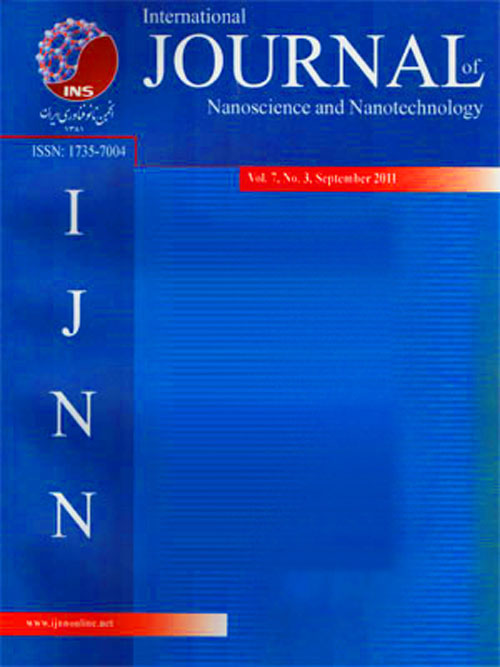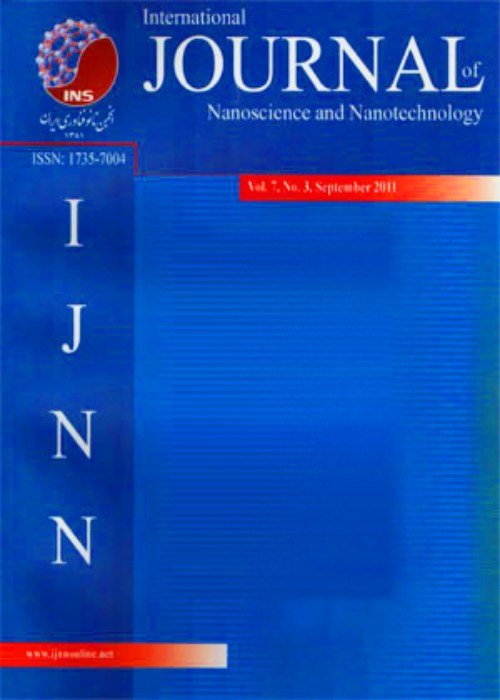فهرست مطالب

International Journal Of Nanoscience and Nanotechnology
Volume:11 Issue: 4, Autumn 2015
- تاریخ انتشار: 1394/10/30
- تعداد عناوین: 9
-
-
Pages 225-232The Full Adders (FAs) constitute the essential elements of digital systems, in a sense that they affect the circuit parameters of such systems. With respect to the MOSFET restrictions, its replacement by new devices and technologies is inevitable. QCA is one of the accomplishments in nanotechnology nominated as the candidate for MOSFET replacement. In this article 4 new layouts are presented for FA; implemented as two at one layer and the other two at three layers; this is performed in a step by step manner and by providing the details and introducing each one’s problems. The layout process continues till an optimized layout is obtained. The layout and correct assessment of the introduced circuit function is accomplished by using QCA Designer simulation tool. The comparison of the results obtained through simulation confirms that the third design is better than other three designs with respect to cell count and area.Keywords: Full adder, Nanotechnology, QCA
-
Pages 233-240The special application of iron-manganese oxide nanocatalysts has been investigated in decomposition of hydrogen peroxide. In this research, iron-manganese oxide nanocomposites were synthesized by co-precipitation, sol-gel and mechanochemical methods using iron (III) nitrate, iron (II) sulfate and manganese (II) nitrate as starting materials. These nanocomposites were prepared on the various catalyst beds. The polyvinyl pyrrolidon was used as a capping agent to control the agglomeration of the nanoparticles. Nanocatalysts were identified by FT-IR, XRD and SEM. The sizes of nanoparticles were determined by XRD data and Scherer equation. Catalytic activity of prepared samples by co-precipitation method was higher than the samples prepared by other methods. Based on surface area analysis and BET data, using of sodium metasilicate bed led to the high surface area and catalytic activity. To optimize the catalytic activity of nanoparticles factors such as concentration, cations ratio, pH and calcination temperature were investigated.Keywords: Hydrogen peroxide, Nanocatalyst, Iron, manganese oxide, Catalyst bed, Infrared spectroscopy, X-ray diffraction, Electron microscopy, Catalytic property
-
Pages 241-248In this paper, Homotopy perturbation method (HPM) has been applied to investigate the effect of magnetic field on Cu-water nanofluid flow in non-parallel walls. The validity of HPM solutions were verified by comparing with numerical results obtained using a fourth order Runge–Kutta method. Effects of active parameters on flow have been presented graphically. The results show that velocity in boundary layer thickness decreased with increase of Reynolds number and nanoparticle volume friction and increased with increasing Hartmann number.Keywords: Nanofluid, Magneto hydro dynamic, Jeffery–Hamel flow, Nonlinear Ordinary differential equation, Homotopy perturbation method
-
Pages 249-256Using Fe(NO3)3.9H2O, Co(NO3)2.6H2O and Mn(NO3)2.4H2O the magnetic properties of nanoparticles trimetalic Iron - Cobalt - Manganese, with supported Magnesium oxide have been prepared by Co-precipitation and Solvothermal methods. The prepared samples are characterized by Scanning Electron Microscope (SEM), X-Ray Diffraction (XRD), Vibrating Sample Magnetometer (VSM) and Brunaer-Emmett-Teller (BET) surface area measurements. Data from SEM showed spherical and nearly uniform spherical shape particles for the samples which were synthesized with support by co-precipitation and by solvothermal methods, respectively. According to the patterns of XRD, the crystal size of the nanoparticles prepared by co-precipitation method with support are in the range of 25 to 30 nm and the size of the particles are in the range of 45 to 50 nm using solvothermal method. The results of the BET from all of the nanoparticles synthesized show that precursors have highest surface area of the calcinated samples. According to the VSM results taken at room temperature (RT), the samples with support after calcination were placed in the category of soft ferromagnetism.Keywords: Catalyst, Co, precipitation, Nanoparticles, Soft ferromagnetism, Solvothermal
-
Pages 257-262Quantum-dot cellular automaton (QCA) is a novel nanotechnology with a very different computational method in compared with CMOS, whereas placement of electrons in cells indicates digital information. This nanotechnology with specifications such as fast speed, high parallel processing, small area, low power consumption and higher switching frequency becomes a promising candidate for CMOS technology. In this paper, a new architecture of Half and Full subtractor based on the QCA is proposed. We take advantage of optimal XOR gate in designing these arithmetic units, which has been already designed based on the QCA majority voter gate. Using this XOR gate in the architecture of designed arithmetic units in this paper, reduces number of used QCA cells to 55 and 136 for Half and Full subtractor, respectively. Proposed design is more efficient in terms of cell counts, covered area and delay, than the conventional subtractors based on the QCA. These subtractors are designed and simulated using QCA Designer 2.0.3.Keywords: Full subtractor, Half subtractor, Majority Voter (MV), Quantum dot cellular
-
Pages 263-273This paper reviews some progressive studies and innovations in cement and concrete materials in nano field. Due to the widespread acceptance of the special properties of nano materials and using them for engineering concrete performance, understanding and directing their properties are not achievable without instructing concepts and investigating interactions among components. Due to achievement of different properties of matters at the nanoscale, evaluating their physical and chemical effects on micro and macro scales in concrete and understanding the mechanisms that govern the interactions of nanoscale materials with appropriate characterization are essential. Advanced characterization techniques should be used for concrete to distinguish components of concrete multiphase composite. The other aim of this study was to better understand the importance of probably future advanced techniques and how they can be used as valuable tools to study the nanostructure and microstructure of cement and cement hydration products.Keywords: Nano, Concrete, Structure, Characterization, Engineering
-
Pages 275-280Cobalt chromite (CoCr2O4) with normal spinel structure, shows catalytic activity for oxidation of unburned methane in the natural gas vehilcles (NGV). In this study, CoCr2O4 nanoparticles were synthesized through a conventional co-precipitation technique and investigated for the catalytic combustion of methane. Cobalt nitrate hexahydrate, chromium nitrate nonahydrate and ammonia solution (25%) were used as the starting materials. The obtained results show that the CoCr2O4 nanospinels were produced as single phase with an average diameter between 25-50 nm.Characterization studies by X- ray diffraction (XRD), N2 adsorption/desorption(BET), field emission scanning electron microscopy (FESEM), transmission electron microscopy (TEM), temperature program oxidation (TPO) and O2- temperature programmed desorption (O2-TPD) were carried out.The specific surface area (SBET) of the synthesized nanoparticles was measured using multiple point Brunauer–Emmett–Teller (BET) method.40 m2.g-1 was obtained for CoCr2O4 nanoparticles. The results revealed that cobalt chromite nanoparticles have significant capability for methane conversion at 435oC.Keywords: Cobalt chromite, Co, precipitation, Methane conversion, Nanoparticles
-
Pages 281-288The field of nanobiotechnology mainly encompasses with physics, biology, chemistry and material sciences and it develops novel therapeutic nano-scale materials for biomedical, drug delivery, cancer therapy and pharmaceutical applications. Silver nanoparticles (AgNPs) have unique physiochemical, biological and environmental properties which make them useful in a wide range of applications, so AgNPs was synthesized using mustard plant. The formation and characterization of AgNPs were investigated using UV-visible spectroscopy, Fourier transform infrared spectroscopy (FTIR),X-ray diffraction (XRD) and transmission electron microscopy (TEM). UV-visible spectroscopy showed surface plasmon resonance peak at about 411 nm. FTIR indicated the role of different functional groups (carboxyl, amine, aromatic and hydroxyl) in the formation process of AgNPs. TEM analysis showed spherical particles with size range 1-35 nm and an average size 14 nm. Our measurements showed that mustard seed exudates could mediate facile and eco-friendly biosynthesis of colloidal spherical AgNPs. Also, we studied influence of concentrations of silver nitrate on stability of biosynthesized AgNPs. The results clearly showed that the stability of biosynthesized AgNPs strongly depended on the concentration of used silver ions and increased with increasing the concentration of silver ions in the biosynthesis process. Our results indicated that AgNPs synthesized at higher concentrations of silver nitrate were more stable.Keywords: AgNPs, Eco, friendly, Metal nanoparticles, Synthesis
-
Fabrication and Characterization of Visible Light active Fe-TiO2 Nanocomposites as NanophotocatalystPages 289-293In this research Fe-TiO2 nanocomposites with different molar ratios of Fe/Ti were prepared as nano-photocatalyst using a modified Sol-Gel process at ambient temperature. Crystallographic properties of nanocomposites were characterized by X-ray Diffraction (XRD). Surface morphology and mean particle size of nanocomposites were specified by Field Emission Scanning Electron Microscopy (FESEM) and light absorption spectrum of nanocomposites was evaluated by Diffuse Reflectance Spectra (DRS). XRD patterns revealed that Fe3+ is successfully substituted by Ti4+ in TiO2 lattice and no rutile phase is present in nanocomposites. From FESEM images it was specified that mean particle size of nanocomposites changed in the range of 28-47nm and narrow size distribution was seen. DRS analysis represented that by doping of Fe into the TiO2 lattice, light absorption spectrum of TiO2 shifted to visible light spectrum and led to decrement in energy band gap of TiO2.Band gap of nano-photocatalysts was in the range of 1.98-2.89 eV.Keywords: Sol, Gel, Nano, photocatalyst, Visible light


